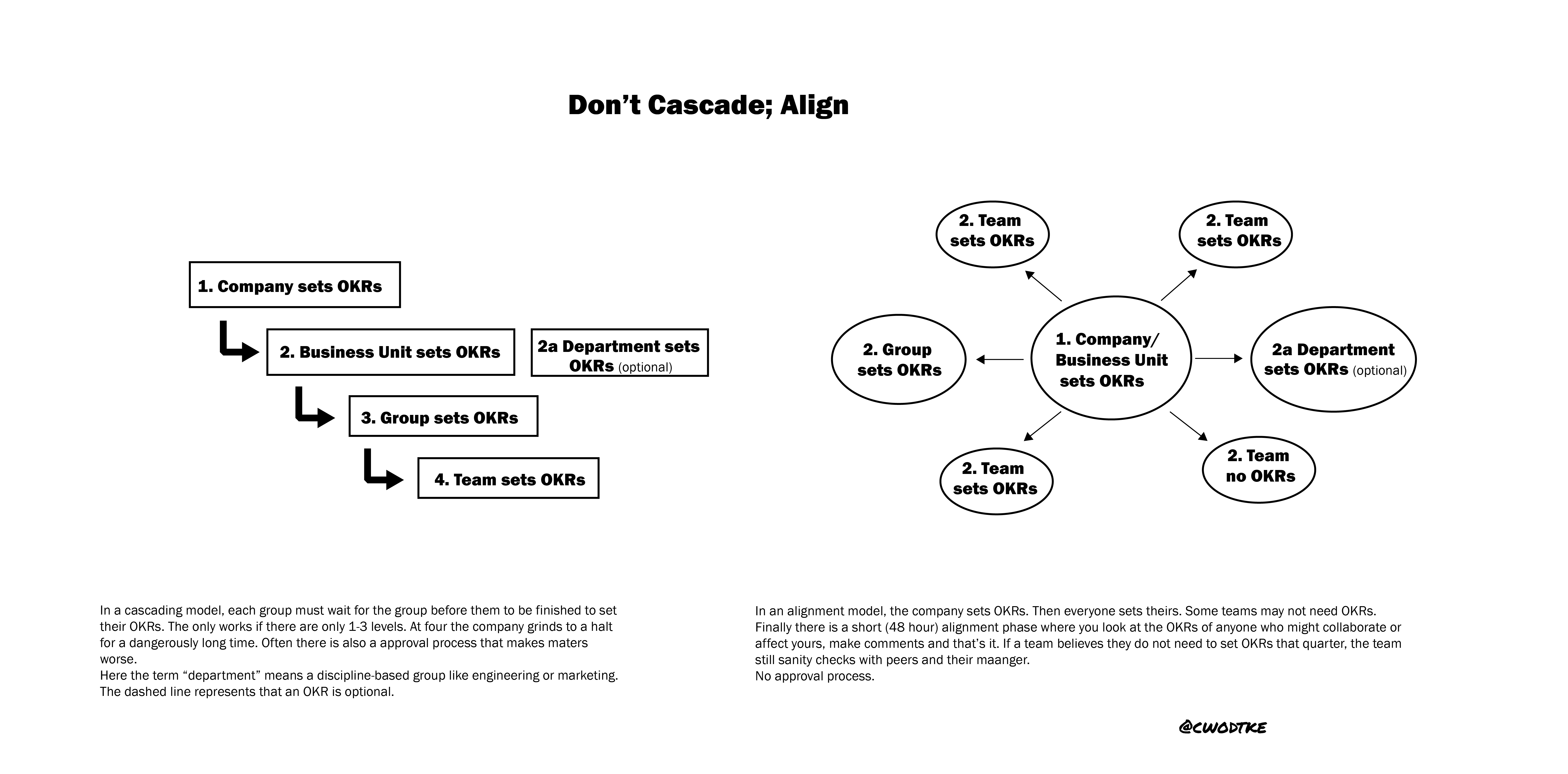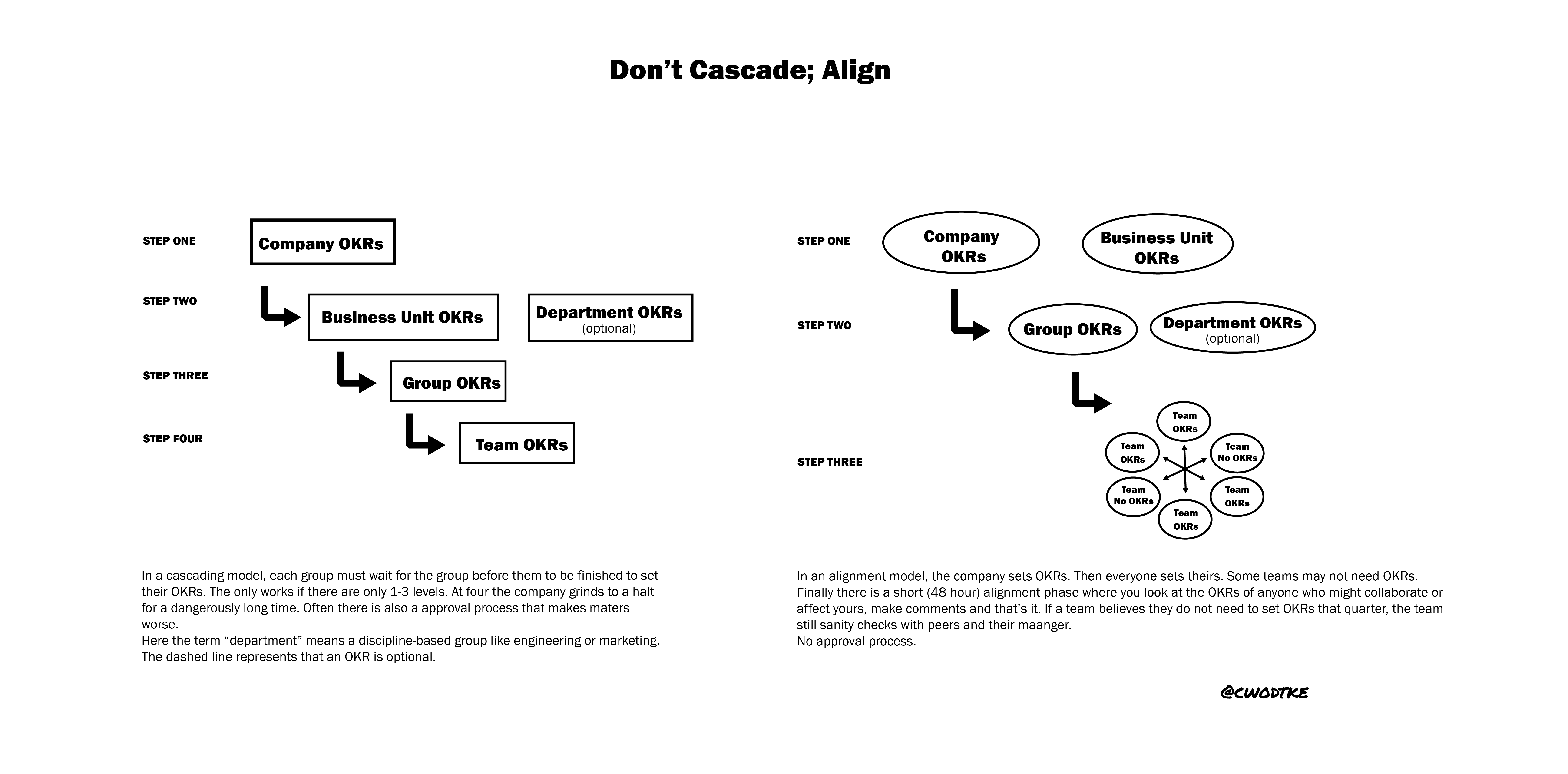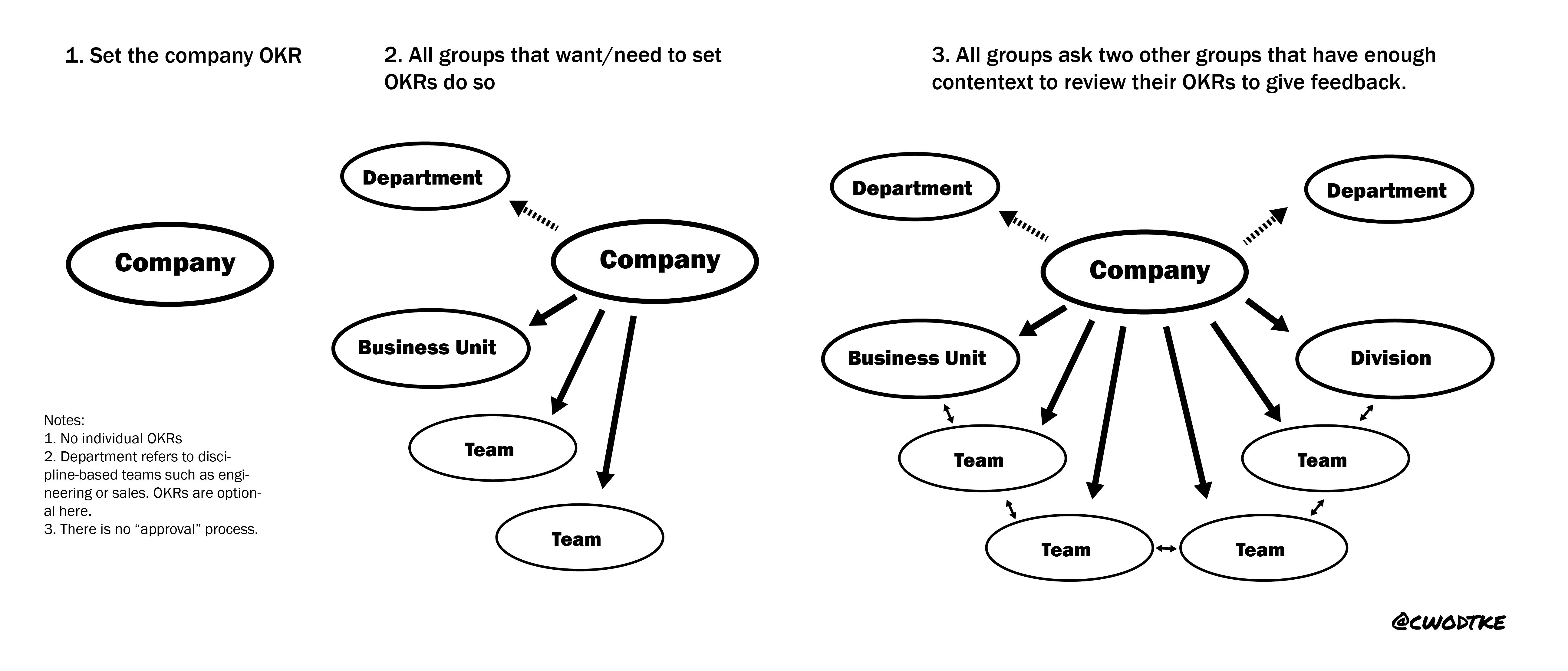OKRs (Objectives and Key Results) are supposed to make everything faster, clearer, and more focused. And when you’re in a small company or early-stage start-up, they often do. When you’re that small, everyone’s probably sitting in the same room and you can hash out the company OKRs in a conversation. Once that’s done, teams decide whether they even need their own OKRs, or if they can just run with the company’s objectives.
Cascading OKRs works here because it’s simple: there’s only one layer to manage. Everyone’s close enough to the work—and each other—that it’s obvious what needs to get done.
But as your company grows, that simplicity starts to break down. You hire more people. Teams multiply. Suddenly, you’ve got layers of management, and not everyone’s in the same room anymore. Communication gets harder, and alignment isn’t as natural as it used to be.
At this point, many companies shift to what’s called aligned OKRs. I’ve been a fan of them in the past!
 Leadership sets the company’s high-level goals, and teams figure out how to support them. It sounds smart—and sometimes it is—but it often turns into a bureaucratic nightmare. Why? Because alignment turns into approval.
Leadership sets the company’s high-level goals, and teams figure out how to support them. It sounds smart—and sometimes it is—but it often turns into a bureaucratic nightmare. Why? Because alignment turns into approval.
Waiting for Approval
When every team has to run their OKRs past leadership for a thumbs-up, things slow to a crawl. Leaders, juggling their own priorities, can take days or weeks to review OKRs. And while teams wait, momentum stalls. People start to feel stuck, not because they don’t know what to do, but because they’re not allowed to start. I’ve tried to solve this with my client, and we’ve made it better. In the model below, you look for another pair of eyes to gut check you and that’s a good thing! But I never asked a critical question; why require this?

Waiting for anpprovals isn’t just frustrating—it’s a sign of something deeper. It’s a trust issue.
The Trust Gap
If you’ve hired great people and given them a clear strategy, you shouldn’t need to approve every little thing. In No Rules Rules, Reed Hastings talks about Netflix’s approach to trust. When you hire incredible talent and make sure everyone understands the strategy, you don’t need heavy-handed control. You can just let go. And if something does go wrong? You deal with it when it happens.
I saw this at Stanford. When I was first hired, I worked closely with a peer. But after about six months the training wheels came off (I never really noticed them) and I’ve been autonomous ever since.
Approval systems are often a sign that leaders don’t fully trust their teams—or maybe their own ability to communicate the strategy clearly. But the irony is, those systems developed to prevent errors only make things worse. They stifle ownership, kill momentum, and send a clear signal: We don’t trust you to figure this out on your own.
What If We Let Go?
Maybe it’s time to rethink the OKR process. Instead of spending so much energy on alignment and approvals, what if we stop worrying about it? What if we decoupled OKRs?
Here’s How It Could Work
1. Leadership Sets the Direction
Leadership’s role is simple: communicate the strategy so clearly that everyone understands where the company is going and what matters most. Based on that strategy, leadership sets a big company-wide OKR set—a bold, inspiring goal that acts as a north star for everyone to follow.
2. Teams Decide Their Own OKRs
Once the company OKRs are set, teams can figure out what they need to do. Maybe they align directly with the company objectives. Maybe they focus on something specific to their function that’s critical for the quarter. Either way, they don’t need to wait for approval—they just start moving.
3. Address Problems As They Arise
Decoupling doesn’t mean mistakes won’t happen. It just means you trust your team enough to act. And when something does go wrong, you handle it. It will take the courage to have the rare hard conversation, but the overall gain in speed and morale is worth it.
You can still get another set of eyes on your OKRs but now it’s recommended not required.

Why Decoupling
Decoupling is built on trust and clarity. If the strategy is clear, teams don’t need someone looking over their shoulder to make sure their OKRs are “aligned.” They already know. And when you’ve hired smart, capable people, they don’t need micromanagement to figure out what to do.
It also forces leadership to focus on what really matters: communication. If your team doesn’t know what to work on without an alignment check, that’s not a process problem—it’s a leadership problem. Decoupling puts the responsibility for clarity where it belongs: at the top.
The Benefits of Decoupling
1. You Move Faster
Teams don’t have to wait for approvals. They set their goals and get to work.
2. Teams Take Ownership
When teams define their own OKRs, they take greater responsibility for achieving them.
3. Sharper Focus
Without the distraction of alignment reviews, everyone can focus on execution.
4. Built-In Resilience
When things change—as they always do—teams can pivot quickly without waiting for top-down guidance.
Getting Back to Work
Decoupling OKRs doesn’t mean giving up on alignment. It’s about trusting your people to align naturally when the strategy is clear and the vision is strong. If leadership does its job well, teams shouldn’t need layers of approval to know they’re on the right track.
Alignment reviews don’t stop mistakes—they just slow everything down. What stops mistakes is hiring great people, setting a clear direction, and trusting them to figure out the rest.